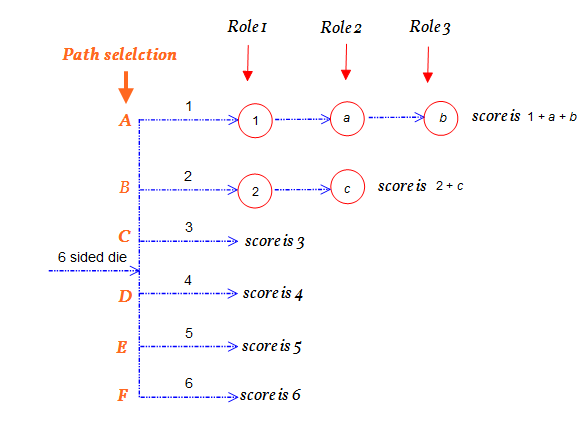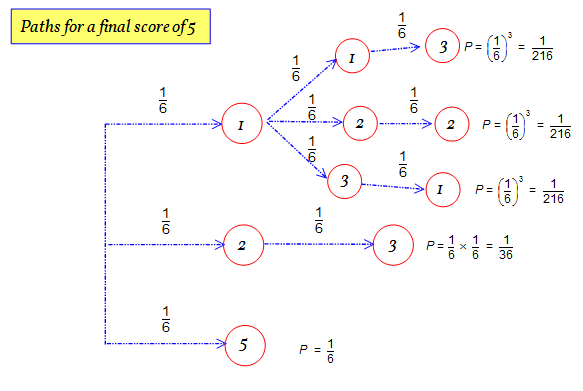A fair #6#-sided die is rolled up to #3# times as described below to give a score. If the score is #5# then what is the probability that it was obtained in #2# rolls?
The die is rolled once.
-
If the first roll is #3, 4, 5, 6# then that is the final score.
-
If the first roll is #2# , then the die is rolled again and #2# added to give the final score.
-
If the first roll is #1# , then the die is rolled twice more, with the final score being the sum of all three rolls.
The die is rolled once.
-
If the first roll is
#3, 4, 5, 6# then that is the final score. -
If the first roll is
#2# , then the die is rolled again and#2# added to give the final score. -
If the first roll is
#1# , then the die is rolled twice more, with the final score being the sum of all three rolls.
4 Answers
Explanation:
What a lovely question!
There are really only 3 outcomes that we must consider to begin with.
There are several ways of ending with a total of 5, but we are only concerned with an outcome of
The first roll MUST give a 2 and the second roll MUST give a 3.
This is the probability of getting a 5 from two rolls...
~~~~~~~~~~~~~~~~~~~~~~~~~~~~~~~~~~~~~~~~~~~~~~~~~~~~~~
However, on a second thought, it seems that the question is more intricate, because, it states that, IF a player gets a 5, what is the probability that it was from two rolls of the dice. This is not quite the same as the first part...
We are told that the player got a 5!!
But, the question remains. how did he get that 5?
How many ways are there of getting a 5?
From first outcome
From second outcome.
From the third outcome, a 5 can only be obtained in the following ways:
For each of these outcomes, the probability is
So, for option 3,
Therefore altogether,
Make the same denominators:
Now, considering that in 216 rolls, there are 45 ways of getting a 5, but only 6 of them come from only 2 rolls.
Probability of a score of 5 having come from 2 rolls:
=
A different approach 1 of 2
Explanation:
A sketch usually helps visualise what is happening:

Key points;
2 roles of the die to reach a score
Final score is 5

Thus the probability of any 5 occurring is
Thus the probability of 5 from path B is
This is conditional probability in that it is categorically stated that the event:
What is the likelihood the
Let the probability of the 5 from path B be
Let the probability of any 5 from all of them be
So we have probability event
This is written
But
'~~~~~~~~~~~~~~~~~~~~~~~~~~~~~~~~
The 5 at the end of path B is shared ( a subset) between path B and the set of all the 5's. In my calculations this is written as
As it is shared it has the 'and' condition.
Probability
Explanation:
Here's another way to look at the problem that I find helps to smooth out any uncertainties over conditional probabilities, etc.
Suppose we change the rules of the game, without changing the probabilities of the outcomes:
Under the new rules, the unbiased six-sided die is rolled exactly three times.
-
If the first roll was a
#3# ,#4# ,#5# or#6# then that is the score for the turn. -
If the first roll was a
#2# , then the value of the second roll is added to give the score. -
If the first roll was a
#1# , then the value of all three rolls is added to give the score.
The probabilities of different scores are exactly the same as if the die was not rolled again after the score had been ascertained.
There are
Of these,
So if the total score is
#6/(36+6+3) = 6/45 = 2/15#
A different approach 2 of 2
Solved by counting
Remember that the 'given' part of a 'conditional probability' defines the sample space.
Explanation:
From solution 1 of 2 we have
'~~~~~~~~~~~~~~~~~~~~~~~~~~~~~~~~~~~~~
Using any common denominator.
So
So



